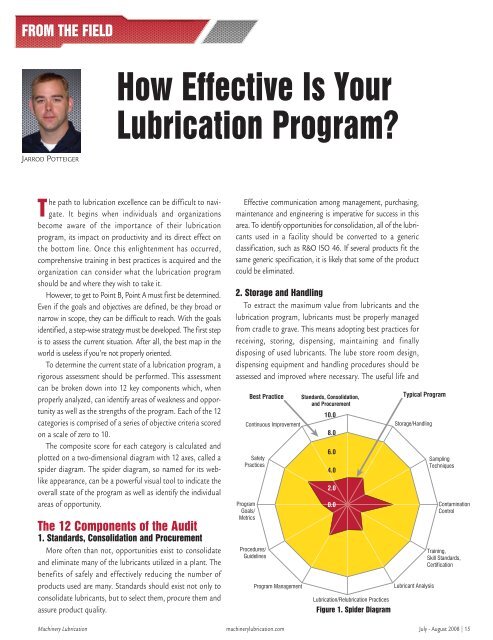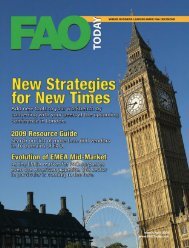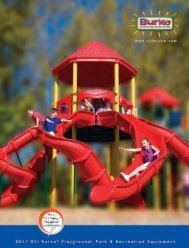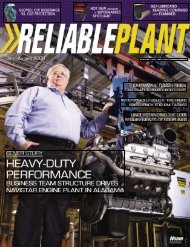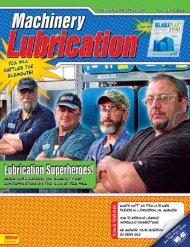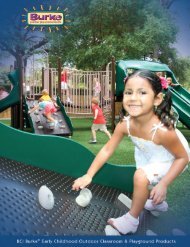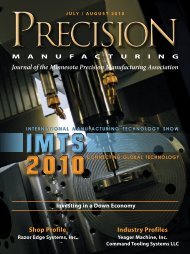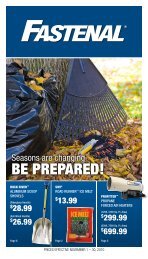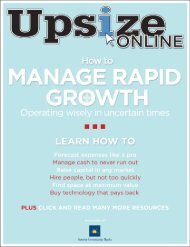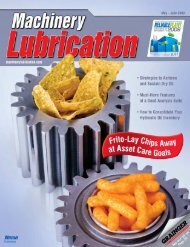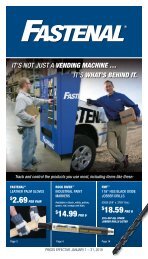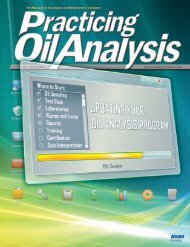Machinery Lubrication July August 2008
Machinery Lubrication July August 2008
Machinery Lubrication July August 2008
Create successful ePaper yourself
Turn your PDF publications into a flip-book with our unique Google optimized e-Paper software.
FROM THE FIELD<br />
How Effective Is Your<br />
<strong>Lubrication</strong> Program?<br />
JARROD POTTEIGER<br />
The path to lubrication excellence can be difficult to navigate.<br />
It begins when individuals and organizations<br />
become aware of the importance of their lubrication<br />
program, its impact on productivity and its direct effect on<br />
the bottom line. Once this enlightenment has occurred,<br />
comprehensive training in best practices is acquired and the<br />
organization can consider what the lubrication program<br />
should be and where they wish to take it.<br />
However, to get to Point B, Point A must first be determined.<br />
Even if the goals and objectives are defined, be they broad or<br />
narrow in scope, they can be difficult to reach. With the goals<br />
identified, a step-wise strategy must be developed. The first step<br />
is to assess the current situation. After all, the best map in the<br />
world is useless if you’re not properly oriented.<br />
To determine the current state of a lubrication program, a<br />
rigorous assessment should be performed. This assessment<br />
can be broken down into 12 key components which, when<br />
properly analyzed, can identify areas of weakness and opportunity<br />
as well as the strengths of the program. Each of the 12<br />
categories is comprised of a series of objective criteria scored<br />
on a scale of zero to 10.<br />
The composite score for each category is calculated and<br />
plotted on a two-dimensional diagram with 12 axes, called a<br />
spider diagram. The spider diagram, so named for its weblike<br />
appearance, can be a powerful visual tool to indicate the<br />
overall state of the program as well as identify the individual<br />
areas of opportunity.<br />
The 12 Components of the Audit<br />
1. Standards, Consolidation and Procurement<br />
More often than not, opportunities exist to consolidate<br />
and eliminate many of the lubricants utilized in a plant. The<br />
benefits of safely and effectively reducing the number of<br />
products used are many. Standards should exist not only to<br />
consolidate lubricants, but to select them, procure them and<br />
assure product quality.<br />
Effective communication among management, purchasing,<br />
maintenance and engineering is imperative for success in this<br />
area. To identify opportunities for consolidation, all of the lubricants<br />
used in a facility should be converted to a generic<br />
classification, such as R&O ISO 46. If several products fit the<br />
same generic specification, it is likely that some of the product<br />
could be eliminated.<br />
2. Storage and Handling<br />
To extract the maximum value from lubricants and the<br />
lubrication program, lubricants must be properly managed<br />
from cradle to grave. This means adopting best practices for<br />
receiving, storing, dispensing, maintaining and finally<br />
disposing of used lubricants. The lube store room design,<br />
dispensing equipment and handling procedures should be<br />
assessed and improved where necessary. The useful life and<br />
Program<br />
Goals/<br />
Metrics<br />
Best Practice<br />
Continuous Improvement<br />
Safety<br />
Practices<br />
Procedures/<br />
Guidelines<br />
Program Management<br />
Standards, Consolidation,<br />
and Procurement<br />
10.0<br />
8.0<br />
6.0<br />
4.0<br />
2.0<br />
0.0 00<br />
<strong>Lubrication</strong>/Relubrication Practices<br />
Figure 1. Spider Diagram<br />
Typical Program<br />
Storage/Handling<br />
Lubricant Analysis<br />
Sampling<br />
Techniques<br />
Contamination<br />
Control<br />
Training,<br />
Skill Standards,<br />
Certification<br />
<strong>Machinery</strong> <strong>Lubrication</strong> machinerylubrication.com <strong>July</strong> - <strong>August</strong> <strong>2008</strong> 15


